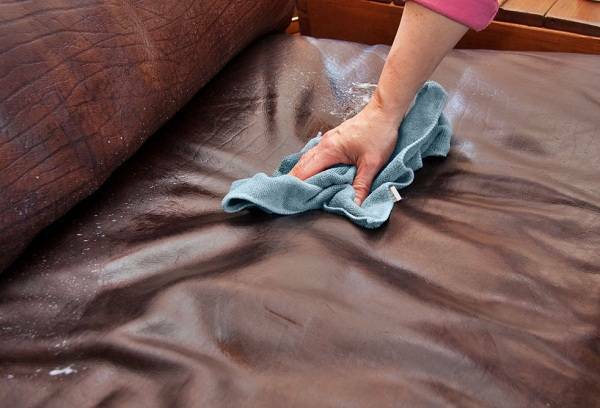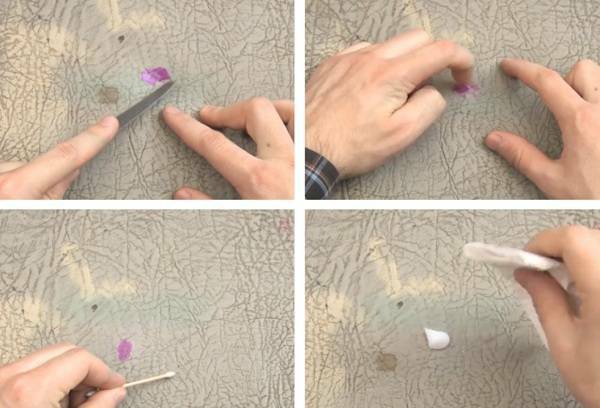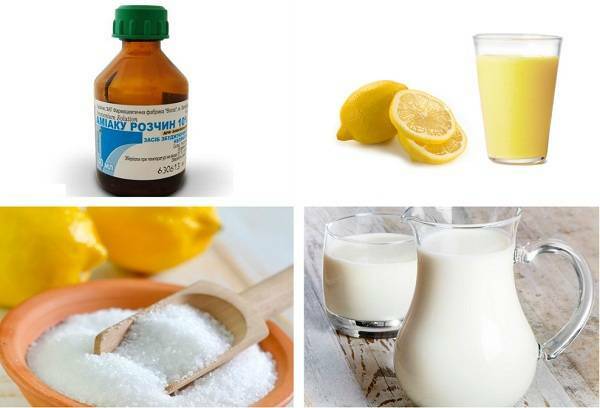Contents:
- Recommendations for cleaning leatherette
- Stain removal depending on type of contamination
- How to clean a leatherette of light colors?
Things from leatherette will look like new for a long time if you provide them with quality and regular care. In addition, each landlady should know how to remove stains and stains from a pretty capricious surface.

Many women face difficulties in this area, becausepersistent formations with sparing means can not be removed easily, and aggressive substances adversely affect the quality of the material. In fact, everything is not so hopeless. Just need to know which products with what type of stains are best cure, and what reagents are better to refuse at all.
Recommendations for cleaning the leatherette
There are several rules for working with things from leatherette, observance of which will, if necessary, quickly and efficiently remove fresh spots and organize a regular regular care of the surface:
- The optimal tool for daily care of products from leatherette are wet wipes. It is with their help that it is recommended to clean off the surface of dust, small dirt. In some cases, they help to get rid of fresh spots.
- Dried stains are categorically prohibited from scraping or rubbing with the help of preparations containing oil products.
- Do not try to remove contamination from leatherette, using solvents, alkalis and strong acids. It is not recommended to use household solutions intended for dishwashing or plumbing treatment.
- In order to prepare stains for further processing, experienced housewives are advised to moisten them with a usual soap solution or water with the addition of a small amount of ammonia.

Generally, it is better to remove contaminants immediately after their detection. Only in this case will a minimum mechanical impact, which usually leads to a rapid wear on the surface of the products.
Stain removal depending on the type of contamination
For qualitative and gentle removal of stains from things from leatherette, it is recommended to use not universal approaches, but means of narrow directivity. This will not only achieve the desired result, but also not affect the color, texture, density of the material.
- Blood spots. If the formulations are fresh, it is worth trying to wipe them with a cloth soaked in cold water. Damped soils should be thoroughly moistened with 3% hydrogen peroxide, applied to a cotton disc, and leave for a couple of minutes. Dirt dissolves and you will only need to wipe the surface clean. Older stains are removed in the same way, but it is better to use a mild soap solution with the addition of a few drops of 5% ammonia.
- Alcoholic beverages, fatty sauces. In this case, the best solution will be soapy water with the addition of vinegar( per cup of water, not more than a tablespoon of caustic product).

Tip: The imitation leather does not like hot water and exposure to hot steam. Use of steam generators or attempts to soak the surface of stains with the help of boiling water can negatively affect the quality of the material, change its color.
- Plasticine, resin, chewing gum. Traces from them can be brought out with ethyl alcohol, the main thing is to wet the surface more and rub less.
- Fruit and vegetable juices, preserves, preserves. Here you need a soapy solution, but with 10% ammonia or citric acid, previously diluted in water.
- Coffee, chocolate, tea. On the stains, you just need to apply a thick foam, obtained by beating the soap composition. After all the bubbles burst, the surface is gently three wet wadded disk and thoroughly rinsed with clean water several times so that no stains remain.
- Cream, oil, lipstick. Fine contaminants are amenable to the use of a soap solution. To clean a large area will have to use turpentine or ethyl alcohol. At the same time, the formations are not just wetted, but rather collected, acting from the periphery to the center.

- Nail polish. Even from the impressive areas of the area, it is easy to remove the liquid for removing varnish without acetone and other aggressive reagents.
- Oil paint. The surface is first treated with turpentine oil. After the main dirt comes off, apply a soap solution, and then - a large amount of clean water. If necessary, repeat the approach.
- Ink from the ballpoint pen. Here is the most common common salt. Well, if it is shallow, otherwise you can scratch the material. The product is added to the soap solution, which is applied to the contamination. Above, for fidelity, you can pour more salt and leave for a few hours. Then remove the entire composition and wipe the leather with clean water.
In cases where the type of stain is not entirely clear, the cleaning should be started with an ordinary soap solution. If the approach does not help, gradually add the auxiliary components, starting with the most sparing( soda, salt) and turning to more aggressive( alcohol, turpentine).
How to clean a leatherette of light shades?
The most accurate thing is to work with products of light colors. If wet wipes do not help, try to remove the contamination in one of the following ways:
- Lemon juice. Take a fresh lemon, cut it in half, squeeze juice into the container, filter the liquid. In it, we soak the cotton pad, squeeze it and apply it to the contaminated surface. Keep at least 20 minutes, every three minutes, dripping a few drops of juice on the surface of the disc. Then remove the cotton swab and slightly three spots with a soft damp sponge, wash it off with clean water.
- Milk. When contamination is surface, it is sufficient to thoroughly rub it with room temperature milk. If that's not enough, add lemon juice to the milk and repeat the manipulation.

- Citric acid( acetic acid). In half a glass of water, we divorce half a teaspoon of citric acid or a teaspoon of table vinegar. The resulting solution is wiped several times, but not a three spot.
- Ammonium alcohol. In 2 parts of lukewarm water, take 1 part of ammonia and half a teaspoon of glycerin, mix well. We apply the composition to the contamination and wait until it dries. Then wash it with clean water, wipe it with a cloth and repeat the manipulation if necessary.
After the surface is finally cleaned, it must be repeatedly soaked with soft dry cloths to remove the liquid as much as possible. If you leave the imitation leather on its own, it can become condensed and dry, which will immediately affect its appearance.



